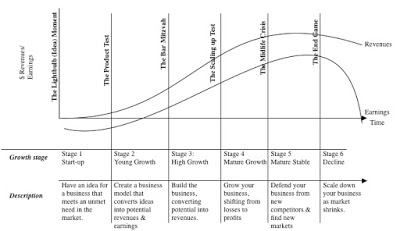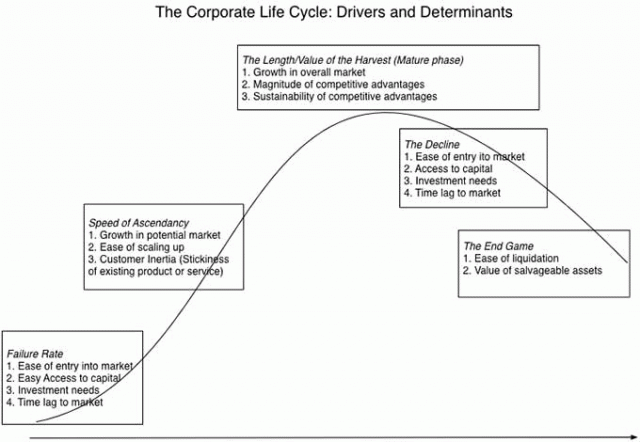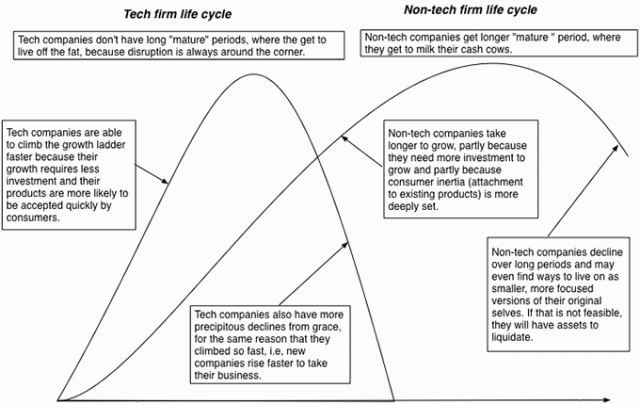The corporate aging theme is one that I have returned to repeatedly in my posts, and I have looked at how the aging process creates dysfunctional responses on the parts of managers, who want to find ways to reverse it, and investors, who make bets on such reversals. It was the under pinning for my last post on Yahoo, and in that post, I argued that technology companies have compressed life cycles, i.e., age in dog years, relative to non-tech companies. In this post, I would like to provide a rationale for why this may be the case and set the stage for my next post on what the implications are for managers and investors.
The Corporate Life Cycle
The corporate life cycle follows a familiar pattern. It begins with an idea, that develops into a product, which evolves into an operating business, that matures, and eventually dies.

I have also highlighted the transitions that determine whether a company moves to the next stage and the mortality rate especially early in the life cycle is high. There are wide differences across companies in how long they take to climb the life cycle, how much time they spend as mature companies and how quickly they decline. As legal entities, corporations do have a little more give in the process, i.e., the capacity to slow or even reverse the process for periods, than individuals do, but not as much as they (and their strategic advisors) think that they do. The one reality that I think is incontestable is that even the most exceptional companies will age and that whether they deal with that aging gracefully is what determines how their stockholders will do during the process.
Determinants of the Life Cycle
To get a sense of what drives differences across companies and how the life cycle evolves, I tried to take a look at the determinants of each phase of the cycle in the graph below:

- When you start up, your focus is survival, and that will depend on (a) how much access you have to capital, (b) how much you need to invest to enter the market and (c) the time lag before you have a product or a service. Your chances of survival improve, if you have access to more capital and don't have to wait very long before you have a functioning product.
Tech versus Non-tech
Before we start on a discussion of how tech companies are different from non-tech companies, we have to think about what separates the two groups, and that separation becomes hazier by the day. In the 1980s, at the start of the tech revolution, the distinction was a simple one. If a company’s products or services were computer-related (either personal or business computers), it was classified as a technology firm. That distinction allowed us to identify Microsoft, Apple and Atari as technology firms, and bring in HP, IBM and Digital Equipment as the old guard. That definition no longer works, as almost every product we buy (from appliances to automobiles) has a computerized component to it, and it has meant that deciding whether a company is a tech company is a judgment call. Given that reality, I would propose that rather than draw hard lines of distinction between tech and non-tech, we consider technology on a continuum, where at one end you have companies whose products and services are entirely technology driven (Google, Facebook) and at the other, you have companies that almost no technology component to them (consumer products and cosmetics companies, for instance). With this continuum, you can argue that Tesla and Ford are both auto companies, but that Tesla has a larger technology component than Ford.
Why do we care about these distinctions? First, they have practical implications for analysts and portfolio managers. Sell-side equity research analysts are usually put into sector silos and asked to keep their focus on the companies that they are assigned. With companies like Amazon, Netflix and Tesla, high profile names to follow, I have noticed that there are big differences across banks. Some assign these companies to the technology analysts, some to the businesses that these companies operate in (Tesla in autos, Netflix in entertainment and Amazon in retail) and some create new sector groupings just for these gray area companies. Second, for better or worse, the categorization of a company can affect its pricing. Tesla, classified as an auto company, will look expensive, compared to other auto companies, but classified as a young tech company, it may look cheap. That is perhaps why companies seek out the tech label for themselves, even if technology is only a small component of their offerings.
The Tech Life Cycle
If you accept my argument that technology is a continuum, then you can perhaps live with my definition of “tech†companies as those that get the predominant portion of their value from technology. With that definition, I can revisit the corporate life cycle and its determinants and make the following generalizations (and I am sure that you can think of exceptions with each one):
- Scaling up is easy: Tech companies often operate in businesses where entry is not restricted, the up front investment is minimal and scaling up in easy. If market conditions are favorable, they are aided and abetted by access to capital and by less sticky customer preferences in their markets. Not surprisingly, tech companies can grow quickly.
Here, for instance, is my contrast between the life cycle of the typical tech company, contrasted with a typical tech company.

Is there evidence that this is what happens in the market? I could use Blackberry as an example, but I would then be guilty of using anecdotal evidence to advance my theory. Instead, I will argue that the evidence exists, albeit in scattered form. First, there is evidence that the small tech firms (that survive the first tests) are able to scale up faster in terms of revenue growth (at least) than small non-tech firms. The fact that they often lose money while doing so is as much a function of the accounting inconsistency of treating research and product development costs as operating expenses, as it a function of operating weakness. The second is that these tech firms, once established, have a more difficult time maintaining growth. The third is that decline, once it starts at tech firms, is more difficult to reverse and quicker to accelerate. All of these points are made in this McKinsey article on growth at tech companies.
A Life Cycle Perspective on Disruption
Disruption is the new buzz word in corporate strategy, a reason that I listed it as on my list of words that operate as weapons of mass distraction, and is often used to cut off debate or not talk specifics. From my perspective, the essence of disruption is a that it is a new way of doing business that radically changes the fundamentals of on established business. In the context of technology-driven disruption, it a company, with a tech model, coming into a non-tech business, characterized by long growth periods, extended mature phases and elongated declines.
Consider car service, i.e., the taxi cab and limo business. The old non-tech model for this business required regulatory approval (making entry difficult) and substantial investment (in cars) in a market governed by customer inertia. Uber and the other ride sharing companies have upended the model by bypassing regulatory approval, not investing in cars and breaking through inertia by reaching out to customers through their smart phones. The results speak for themselves. Not only have Uber, Lyft and Didi Kuaidi grown at rates unlike any seen by traditional car service companies, but each has a market reach that is beyond the old model. No traditional cab company can afford to operate in 300 cities, like Uber does.
The effect of disruption is that it upends the fortunes of mature companies from the old business model, coasting in their mature phase, convinced that change is slow. Unprepared for the speed of change emanating from the tech entrants, these old players wait too long to respond, looking to regulators and rule makers for protection, and not surprisingly, face an implosion. That, in a nutshell, is what has happened to the taxi cab and limo business in many cities. The new entrants, though, should not celebrate too quickly, since their tech model disruption comes with its dangers. Their models are difficult to mine for cash flows and are themselves susceptible to competition. As I noted in my post on the future of the ride sharing business, disruption is easy, but making money on disruption is hard.
This article first appeared in Aswath Damodaran’s blog.
(Aswath Damodaran is a professor of finance at the Stern School of Business at NYU.)







